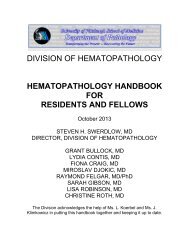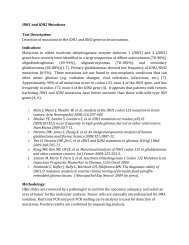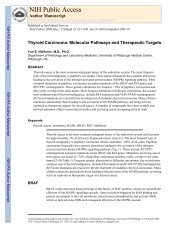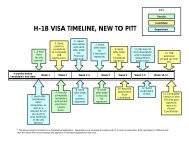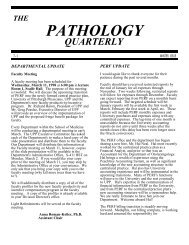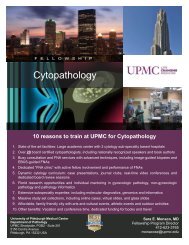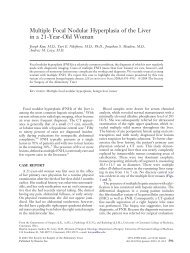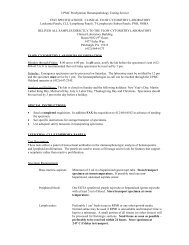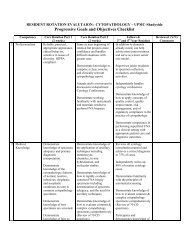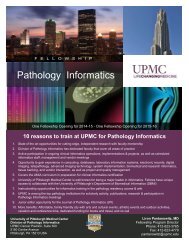Topological basis of signal integration in the transcriptional ...
Topological basis of signal integration in the transcriptional ...
Topological basis of signal integration in the transcriptional ...
You also want an ePaper? Increase the reach of your titles
YUMPU automatically turns print PDFs into web optimized ePapers that Google loves.
BMC Bio<strong>in</strong>formatics 2006, 7:478<br />
http://www.biomedcentral.com/1471-2105/7/478<br />
efforts that start with mapp<strong>in</strong>g out potential regulatory<br />
<strong>in</strong>teractions that exist <strong>in</strong> a given cell type. In <strong>the</strong> yeast Saccharomyces<br />
cerevisiae and <strong>in</strong> <strong>the</strong> bacterium Escherichia coli,<br />
<strong>the</strong> static 'wir<strong>in</strong>g diagrams' <strong>of</strong> potential TF-mediated <strong>in</strong>teractions<br />
have been mapped out to such a degree [4-7] that<br />
<strong>the</strong>ir system-level characteristics and function can be<br />
<strong>in</strong>vestigated. Subsequent computational analyses have<br />
shown that <strong>in</strong> both TR networks <strong>the</strong> regulatory <strong>in</strong>teractions<br />
between TFs and <strong>the</strong> regulated genes are <strong>of</strong>ten organized<br />
<strong>in</strong>to basic <strong>in</strong>formation process<strong>in</strong>g subgraphs, called<br />
motifs [8] that can form even larger potential <strong>in</strong>formation<br />
process<strong>in</strong>g units, such as motif clusters [9], <strong>the</strong>mes and<br />
<strong>the</strong>matic maps [10], and <strong>transcriptional</strong> modules [11]. It<br />
is also evident that <strong>the</strong> TR network is utilized <strong>in</strong> a condition-specific<br />
manner [12], perhaps through <strong>the</strong> activation<br />
<strong>of</strong> dist<strong>in</strong>ct, <strong>signal</strong>-specific subnetworks [13]. In spite <strong>of</strong><br />
<strong>the</strong>se advances <strong>the</strong> pr<strong>in</strong>ciples along which regulatory networks<br />
process <strong>signal</strong>s, encode <strong>the</strong> relevant <strong>signal</strong>s at different<br />
layers <strong>of</strong> <strong>the</strong> network, and <strong>in</strong>tegrate <strong>the</strong>m with o<strong>the</strong>r<br />
<strong>signal</strong>s rema<strong>in</strong> poorly understood.<br />
Here we show that regulatory <strong>in</strong>teractions among an <strong>in</strong>termediate<br />
layer <strong>of</strong> transcription factors is a key determ<strong>in</strong>ant<br />
<strong>of</strong> <strong>in</strong>formation transfer with<strong>in</strong> <strong>the</strong> S. cerevisiae TR network,<br />
and that this layer naturally segregates <strong>in</strong>to dist<strong>in</strong>ct,<br />
sparsely communicat<strong>in</strong>g subnets <strong>in</strong> which TFs are densely<br />
<strong>in</strong>terl<strong>in</strong>ked <strong>in</strong> a hierarchical manner. We also show that<br />
TFs and <strong>the</strong> genes regulated by <strong>the</strong>m respond to external<br />
<strong>signal</strong>s by utiliz<strong>in</strong>g various fractions <strong>of</strong> <strong>the</strong>se subnetworks.<br />
The identified features suggest a model <strong>in</strong> which successive<br />
waves <strong>of</strong> <strong>transcriptional</strong> regulation <strong>of</strong> gene expression<br />
via multiple <strong>in</strong>terferences at various levels <strong>of</strong> TF <strong>in</strong>teraction<br />
hierarchy constitute a key feature <strong>of</strong> develop<strong>in</strong>g<br />
robust <strong>in</strong>tegrated responses to complex stimuli.<br />
Results<br />
Hierarchies and <strong>signal</strong>-specific subnets <strong>in</strong> <strong>the</strong> S. cerevisiae<br />
TR network<br />
With <strong>the</strong> exception <strong>of</strong> a few mutually regulat<strong>in</strong>g pairs, <strong>the</strong><br />
l<strong>in</strong>ks <strong>of</strong> <strong>the</strong> S. cerevisiae TR network are unidirectional, and<br />
its nodes can be arranged <strong>in</strong>to three ma<strong>in</strong> layers based on<br />
<strong>the</strong>ir position, regulation, and function. The layers reflect<br />
<strong>the</strong> flow <strong>of</strong> <strong>in</strong>formation from <strong>the</strong> <strong>in</strong>put nodes (TFs not<br />
regulated <strong>transcriptional</strong>ly by o<strong>the</strong>r TFs), through <strong>in</strong>termediate<br />
TFs to <strong>the</strong> output nodes (non-TF prote<strong>in</strong>s) (Fig. 1A);<br />
a path from an <strong>in</strong>put to an output node conta<strong>in</strong>s usually<br />
1 to 3 steps, and <strong>the</strong> maximum length is 8 steps.<br />
In <strong>the</strong> S. cerevisiae TR network each TF regulates a limited<br />
number <strong>of</strong> target genes (<strong>in</strong>termediate layer TFs and/or<br />
output prote<strong>in</strong>s), with an average number <strong>of</strong> 34.3. As<br />
described recently for <strong>the</strong> TR network <strong>of</strong> E. coli [13], <strong>the</strong><br />
genes directly or <strong>in</strong>directly regulated by a given <strong>in</strong>put TF<br />
form a <strong>signal</strong>-specific subnet, or origon, and <strong>the</strong> nodes at<br />
<strong>the</strong> <strong>in</strong>termediate and output layers <strong>of</strong> <strong>the</strong> origons are <strong>of</strong>ten<br />
shared by two or more origons. Figure 1A illustrates two<br />
overlapp<strong>in</strong>g origons, orig<strong>in</strong>at<strong>in</strong>g from <strong>the</strong> <strong>in</strong>put TFs Yap1<br />
and Skn7. S<strong>in</strong>ce <strong>the</strong> network conta<strong>in</strong>s 54 <strong>in</strong>put TFs, <strong>the</strong>re<br />
is a total <strong>of</strong> 54 origons <strong>in</strong> <strong>the</strong> S. cerevisiae TR network, <strong>of</strong><br />
which only two are isolated from <strong>the</strong> rest <strong>of</strong> <strong>the</strong> network<br />
(<strong>the</strong> origons <strong>of</strong> Pdr3 and Zap1) (Fig. 1B).<br />
Classification <strong>of</strong> <strong>the</strong> yeast TR network based on its global<br />
topological properties<br />
To ga<strong>in</strong> <strong>in</strong>sight <strong>in</strong>to <strong>the</strong> overall yeast TR network organization<br />
we first assessed <strong>the</strong> connectivity distribution <strong>of</strong> all<br />
nodes (each represent<strong>in</strong>g a gene and its product), and separately<br />
those <strong>of</strong> <strong>in</strong>put TFs, <strong>in</strong>termediate TFs, and output<br />
genes, us<strong>in</strong>g cumulated distributions that are equivalent<br />
to rank-degree (or Zipf-) plots. Due to <strong>the</strong> <strong>in</strong>herent directionality<br />
<strong>of</strong> <strong>the</strong> l<strong>in</strong>ks, we separately analyzed <strong>the</strong> number<br />
<strong>of</strong> regulat<strong>in</strong>g TFs per regulated gene (<strong>in</strong>com<strong>in</strong>g l<strong>in</strong>ks, k <strong>in</strong> )<br />
and <strong>the</strong> number <strong>of</strong> regulated genes per TF (outgo<strong>in</strong>g l<strong>in</strong>ks,<br />
k out ), to determ<strong>in</strong>e if <strong>the</strong>ir distributions are best approximated<br />
by exponential-like [14] or power-law [15] models.<br />
(Hubs, i.e., TFs with large numbers <strong>of</strong> l<strong>in</strong>ks, are absent<br />
from exponential-like models, while <strong>the</strong>y are present and<br />
ra<strong>the</strong>r significant <strong>in</strong> <strong>the</strong> power-law model.) We f<strong>in</strong>d that<br />
<strong>the</strong> distribution <strong>of</strong> <strong>the</strong> number <strong>of</strong> <strong>in</strong>com<strong>in</strong>g l<strong>in</strong>ks per<br />
node, k <strong>in</strong> , displays an exponential decay (see <strong>in</strong>set <strong>of</strong> Fig.<br />
1C), as previously described [16], while that <strong>of</strong> outgo<strong>in</strong>g<br />
l<strong>in</strong>ks shows an <strong>in</strong>termediate behavior between exponential-like-<br />
and power-law decay models (Fig. 1C).<br />
Interest<strong>in</strong>gly, <strong>the</strong> outgo<strong>in</strong>g l<strong>in</strong>ks for <strong>in</strong>put TFs closely<br />
approximate an exponentially decay<strong>in</strong>g degree distribution,<br />
(i.e., hub sizes are limited), while a few <strong>of</strong> <strong>the</strong> <strong>in</strong>termediate<br />
TFs are unexpectedly large hubs resembl<strong>in</strong>g more<br />
closely <strong>the</strong> power-law models. Also, <strong>the</strong> outdegrees <strong>of</strong><br />
<strong>in</strong>termediate TFs tend to be larger than those <strong>of</strong> <strong>in</strong>put<br />
nodes (Supplementary Fig. S1). Taken toge<strong>the</strong>r, <strong>the</strong> cumulative<br />
<strong>in</strong>- and outdegree distributions suggest that <strong>the</strong><br />
yeast TR network belongs to a mixed class <strong>of</strong> networks<br />
(between exponential and power-law [17]), where <strong>the</strong><br />
number <strong>of</strong> connections per node is likely to be constra<strong>in</strong>ed<br />
both by <strong>the</strong> limited size <strong>of</strong> a target gene's promoter<br />
region [16], and perhaps by <strong>the</strong> biosyn<strong>the</strong>tic costs<br />
<strong>of</strong> ma<strong>in</strong>ta<strong>in</strong><strong>in</strong>g regulatory <strong>in</strong>teractions [17].<br />
Distribution <strong>of</strong> graph motifs <strong>in</strong> <strong>the</strong> yeast TR network<br />
The effects <strong>of</strong> many external and <strong>in</strong>ternal <strong>signal</strong>s are manifested<br />
by altered TF activity, followed by <strong>the</strong> propagation<br />
<strong>of</strong> <strong>the</strong> perturbation to nodes <strong>of</strong> lower layers. Small circuits<br />
(or subgraphs) play a key role <strong>in</strong> this propagation; <strong>the</strong>y<br />
<strong>of</strong>ten connect nodes <strong>of</strong> different regulatory layers to each<br />
o<strong>the</strong>r. Of <strong>the</strong>se, overrepresented subgraphs (motifs) are<br />
likely to enhance <strong>the</strong> versatility <strong>of</strong> <strong>in</strong>formation process<strong>in</strong>g<br />
<strong>in</strong> a TR network [8,18], and may have become abundant<br />
due to <strong>the</strong> overall functional robustness <strong>the</strong>y provide dur-<br />
Page 2 <strong>of</strong> 12<br />
(page number not for citation purposes)



